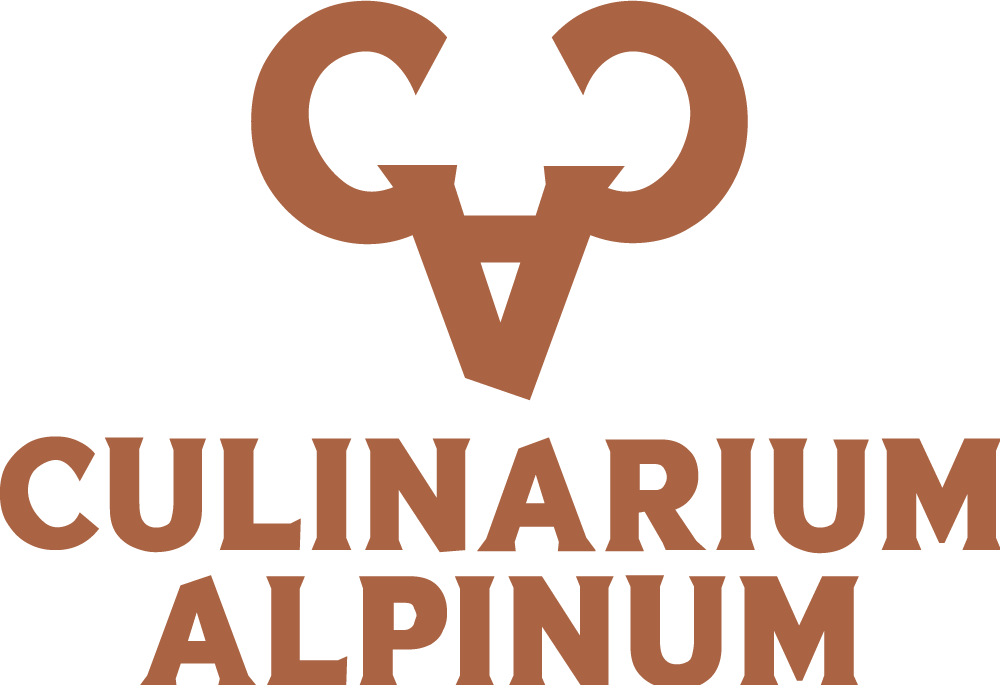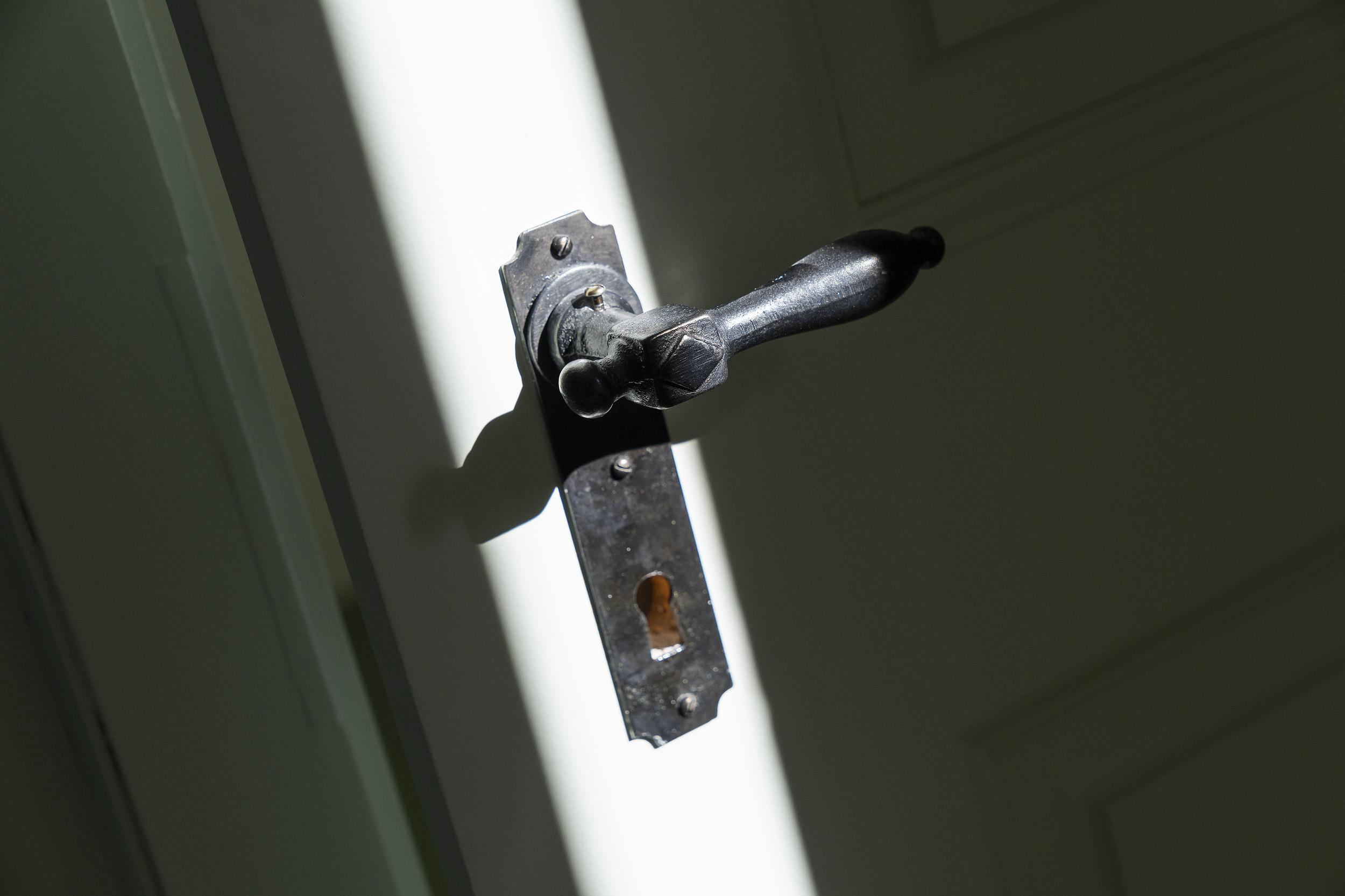Welcome to the CULINARIUM ALPINUM – information about the media guide
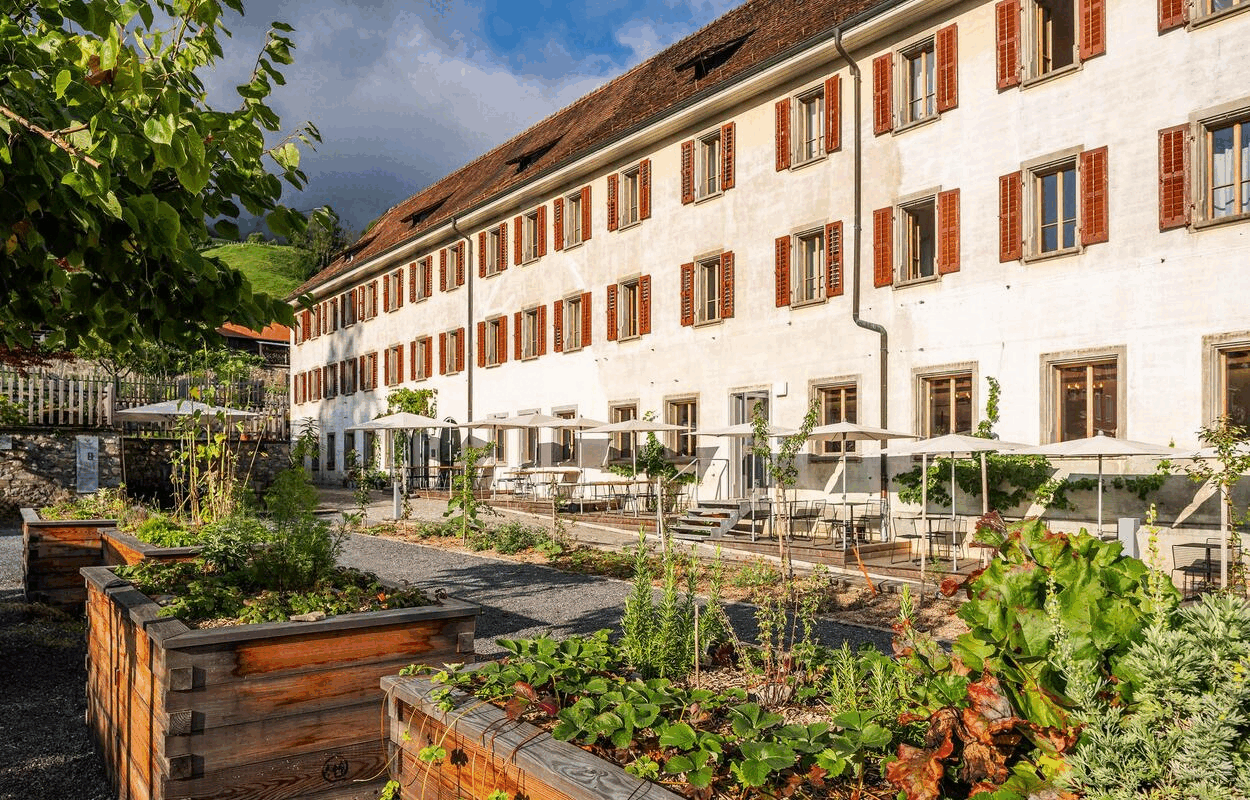
Welcome to the CULINARIUM ALPINUM – information about the media guide
Welcome to the CULINARIUM ALPINUM – information about the media guide
The Culinarium Alpinum is a unique place where history, enjoyment and the diversity of the Alpine culinary heritage come together. Andres Lietha, Managing Director of the KEDA Foundation, welcomes you warmly!
The building you are in has had an eventful past. It was built in 1584 as a Capuchin monastery and served the brothers as a place of prayer, education and community service for almost 400 years. Since 2020, the monastery has been shining in new splendour – as a centre for Alpine culinary culture. Here, the connection between traditional foods, innovative gastronomy and sustainable craftsmanship is cultivated and celebrated. Author Dominik Flammer explored this topic for a wide audience in his book on the culinary heritage of the Alps, making it accessible to all, and is considered the initiator of the Culinarium Alpinum.
During your tour of the monastery, you will have the opportunity to immerse yourself in the history of the building and discover its rooms. We invite you to pause, enjoy and gain new perspectives on the interplay between enjoyment and responsibility.
This media guide has been created to provide our visitors with free and easy access to background information about the CULINARIUM ALPINUM, and we are delighted that you are taking advantage of this offer. Please note that due to private or public events and seasonal availability, not all stations or rooms may be accessible. We kindly ask you to be considerate of other guests during your tour and not to disrupt operations.
If you have difficulty climbing stairs, a lift is available at the rear of the monastery, near the toilets towards Stanserhorn.
In addition to this media guide, we are also happy to offer personal guided tours to interested visitors. During the personal tour, we will go into more detail about all the elements of this media guide. It is also possible to combine this with other offers such as seminars, tastings and cooking courses. Please do not hesitate to contact us or visit our website www.culinarium-alpinum.ch for more information.
Do you need help during the tour? Please speak to our staff or report to reception.
Do you have any feedback on this media guide? Then we look forward to hearing from you at keda@culinarium-alpinum.ch.
Please proceed to the first stop on the tour, which is located in the cloister. There you will learn more about the philosophy of the hotel. The cloister is located on the ground floor, between the restaurant and the second courtyard towards Stanserhorn.

Our philosophy
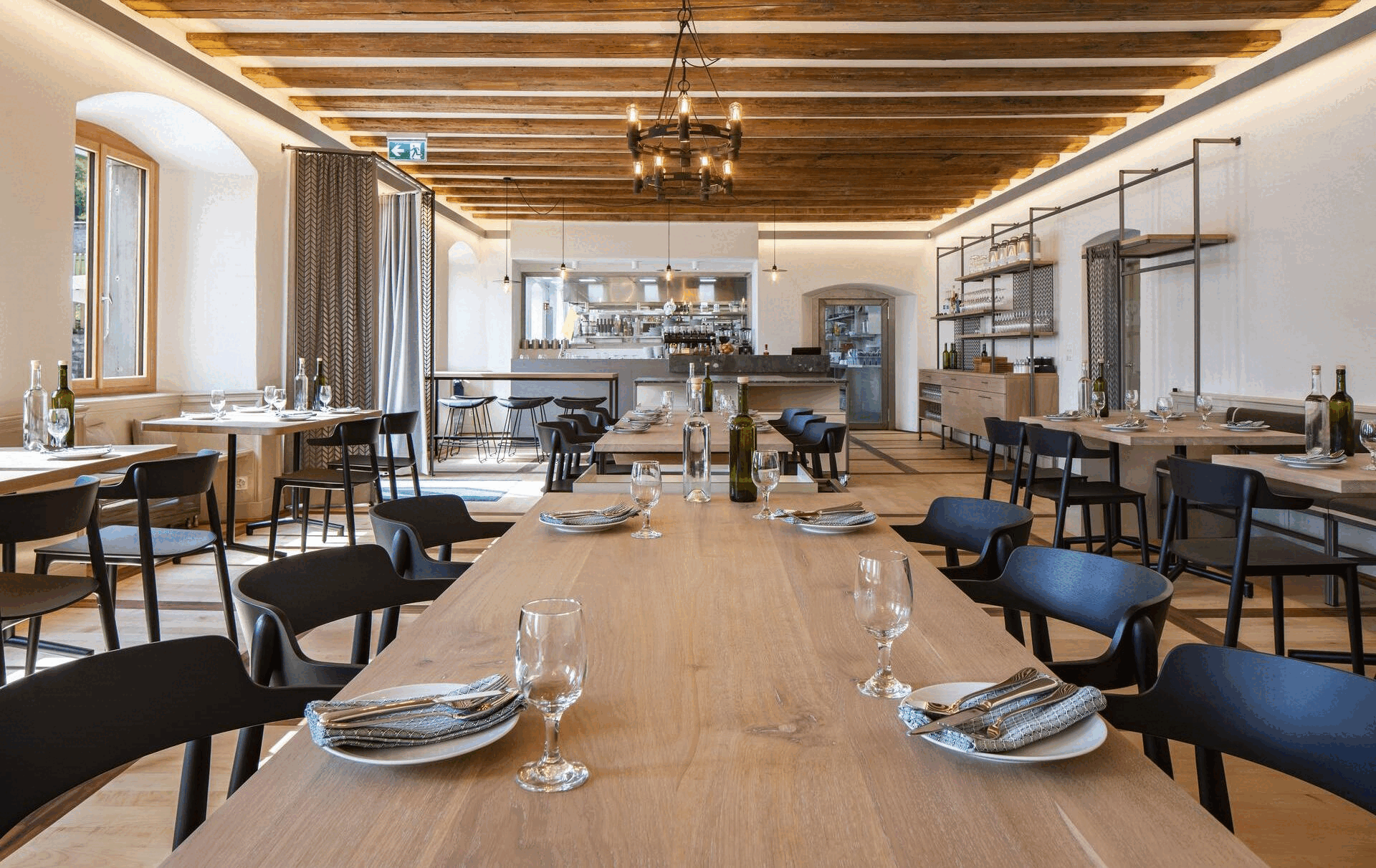
Our philosophy
Our philosophy
The Alpine region offers an astonishing culinary diversity: from spicy cheeses and aromatic herbs to rare, almost forgotten fruits and vegetables. The Culinarium Alpinum has set itself the task of preserving these treasures and bringing them to life. We don’t just want to tell stories, we want to invite you to actively immerse yourself in the experience: Whether over a meal in the restaurant, browsing through our monastery shop and library, or at a wine tasting in the wine bar.
At the heart of our work is the promotion of regional producers and sustainable agriculture, which are closely linked to other players in the value chain and can thus form a regional food and enjoyment system. We are convinced that the future of food lies in a return to local and seasonal produce. By promoting short transport routes and traditional methods, we are not only contributing to sustainability, but also strengthening the cultural identity of our region.
The cloister was once a place of silence and contemplation. Here, the Capuchin friars would stroll, ‘cross paths’, pray and meditate. Today, the cloister connects the historic rooms of the monastery and is a hub for events and encounters. The two inner courtyards bordering the cloister are a popular spot for aperitifs and lunch in summer. In the corridors of the cloister, you can see pictures by Lucerne photographer Sylvan Müller, who contributed the photos to Dominik Flammer’s book ‘Das Kulinarische Erbe der Alpen’ (The Culinary Heritage of the Alps).
Please now go to the end of the cloister, through the glass door and turn right through another glass door into the corridor. Before the corridor bends, you will find the cooking studio on the left.

Ground floor: cookery studio
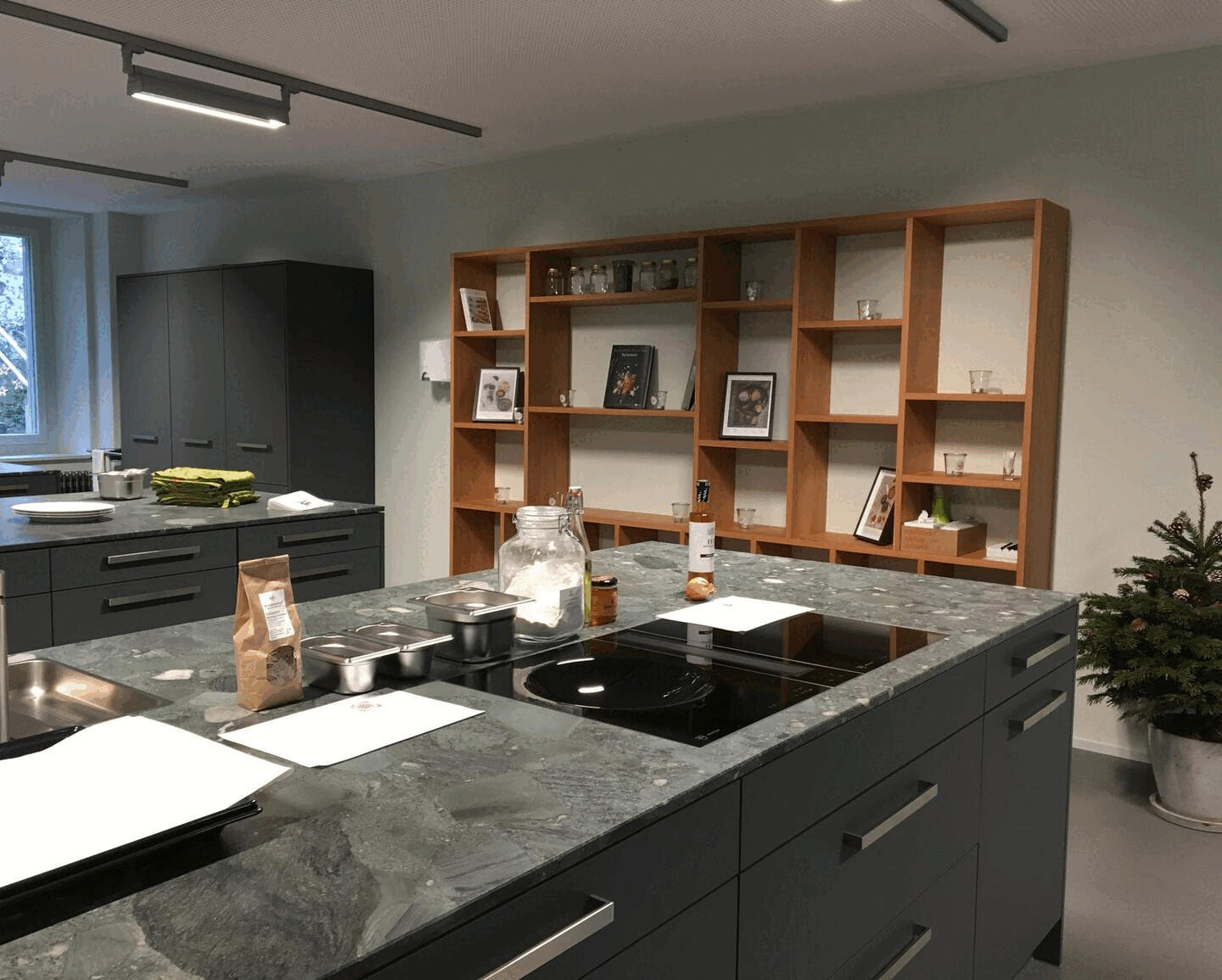
Ground floor: cookery studio
Ground floor: cookery studio
The Goms cooking studio offers three fully equipped cooking islands and is ideal for cooking classes or tastings for up to 20 people. State-of-the-art kitchen appliances, induction hobs and ample space provide the ideal conditions for learning more about baking, preserving, fermenting or even making your own sausages. Our classic cooking courses are: Easter lamb, brother rooster or appetisers for the end of the year.
Seminar guests and private groups can hire the cooking studio and organise their own courses or events there.
The work surfaces are made of Valais stone and are designed to resemble a glacier stream.
Leave the cooking studio, go around the bend in the corridor and continue straight ahead. You are now behind the scenes of our house and will find the inconspicuous door to the inner choir on the right-hand side.

Ground floor: the inner choir
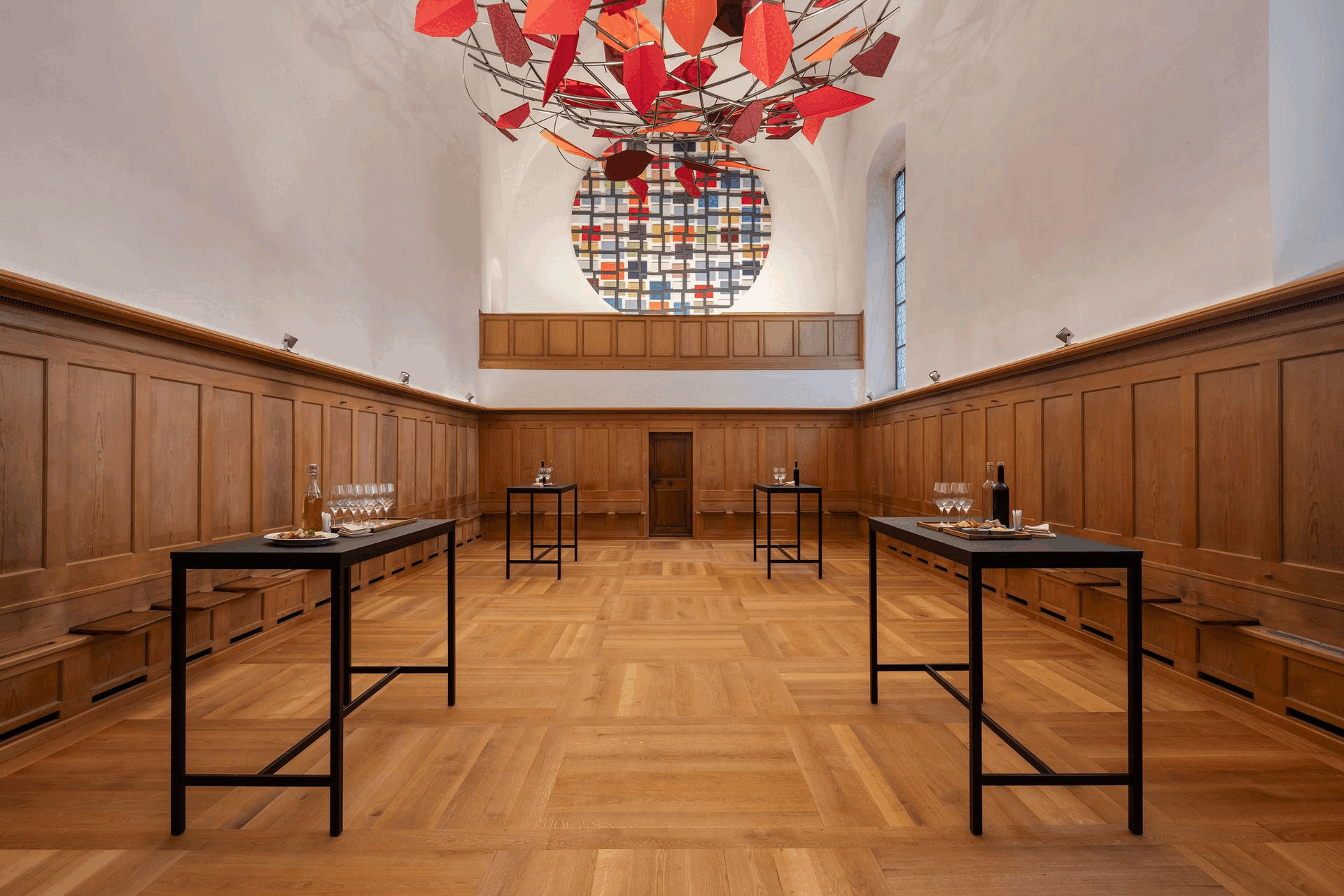
Ground floor: the inner choir
Ground floor: the inner choir
The inner choir was once a sacred space, but is now separated from the church and serves as an event venue for larger specialist events, lectures and seminars, as well as concerts and meals. The space was gently renovated in 2024, with improvements made to both the lighting and acoustics.
The two works of art are by award-winning Swiss artist Beat Zoderer.
With his distinctive objects and installations, he is an established figure on the Swiss art scene and has also made a name for himself internationally. The artwork on the wall refers to the church windows, while the installation in the centre of the room represents the edible landscape of the monastery garden with its coloured leaves. His art is surprising and captivating in the way it questions visual conventions. In addition to enhancing the visual appeal of the room, the two works of art also improve the acoustics.
You are now welcome to open the door at the front right-hand end of the inner choir and take a look at the altar of the monastery church.
Tip: At the end of the tour, take a detour to the monastery church if you would like to see it from the other side.

The monastery church: the history of the Capuchins in Stans
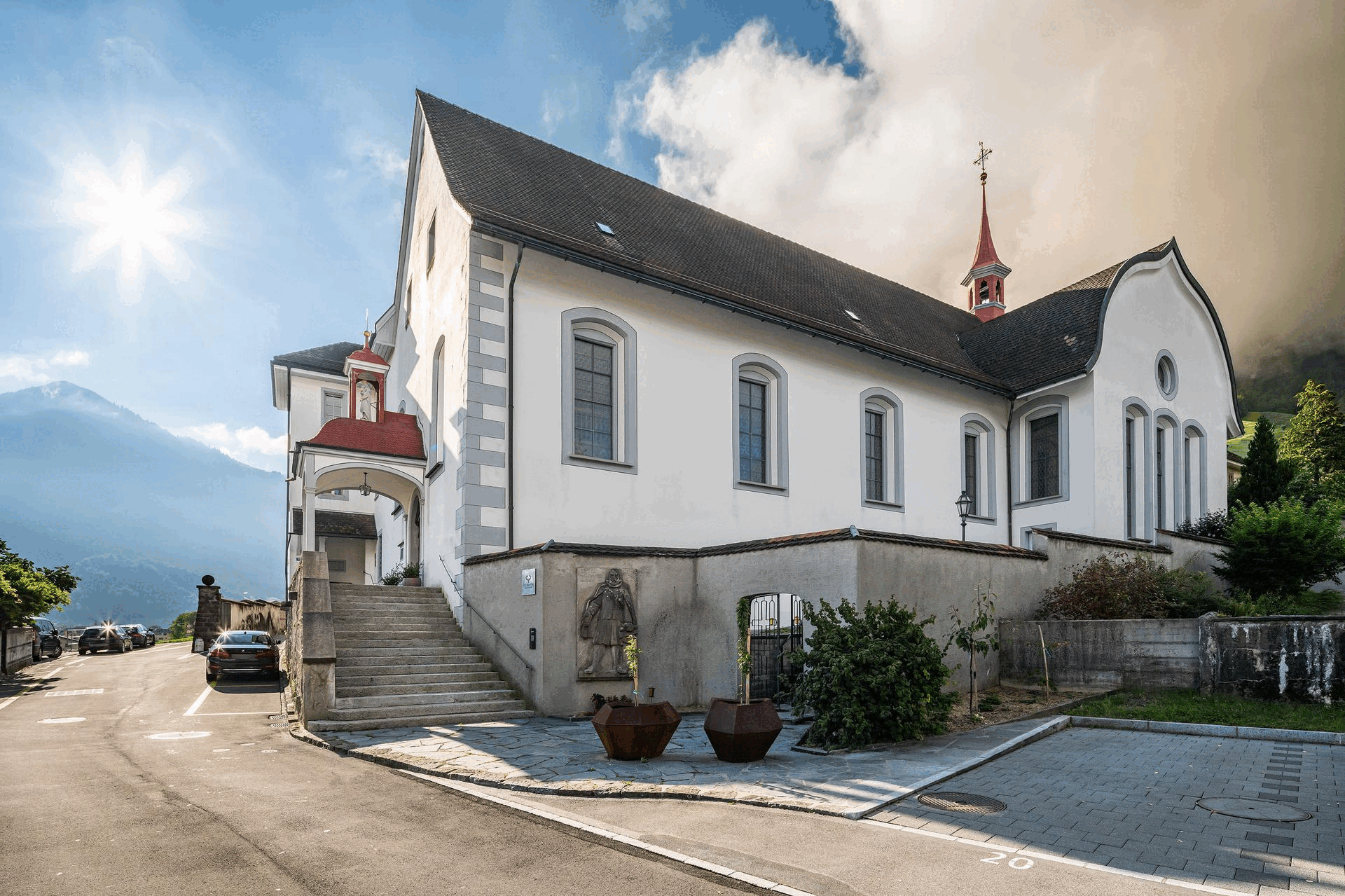
The monastery church: the history of the Capuchins in Stans
The monastery church: the history of the Capuchins in Stans
The monastery church is the oldest evidence of the Capuchins in Stans. It stands at the centre of almost 400 years of history marked by modesty, community and charity.
The Capuchins were a branch of the Franciscan order that consciously dedicated themselves to poverty and simplicity and emerged during the Counter-Reformation. These principles are also reflected in the architecture of the church. The original church was built in 1584 facing south and was simple and functional. It was rebuilt in the 17th century and given its current form. Typical of the Capuchin style are the unadorned walls, the woodwork and the simple but dignified atmosphere.
The monastery played a central role in the spiritual and social life of Stans for centuries. The brothers were not only pastors, but also advisors and teachers – for over 100 years they ran the adjacent St. Fidelis College, which is now the public grammar school of the canton of Nidwalden. During the French occupation in 1798, the monastery was severely damaged, but not the church, as it was used as a stable. Years of reconstruction followed, and until the 20th century, the monastery remained a place of education and reflection.
Today, the church serves as a venue for around 150 church services per year and is also used as an event space for cultural and social events. However, the peaceful and spiritual atmosphere has been preserved.
Now leave the inner choir through the door on the front right-hand side and continue through the foyer, through the glass door to the end of the corridor. Turn right and enter the wine shop.

Ground floor: Wine cellar – our walk-in wine list
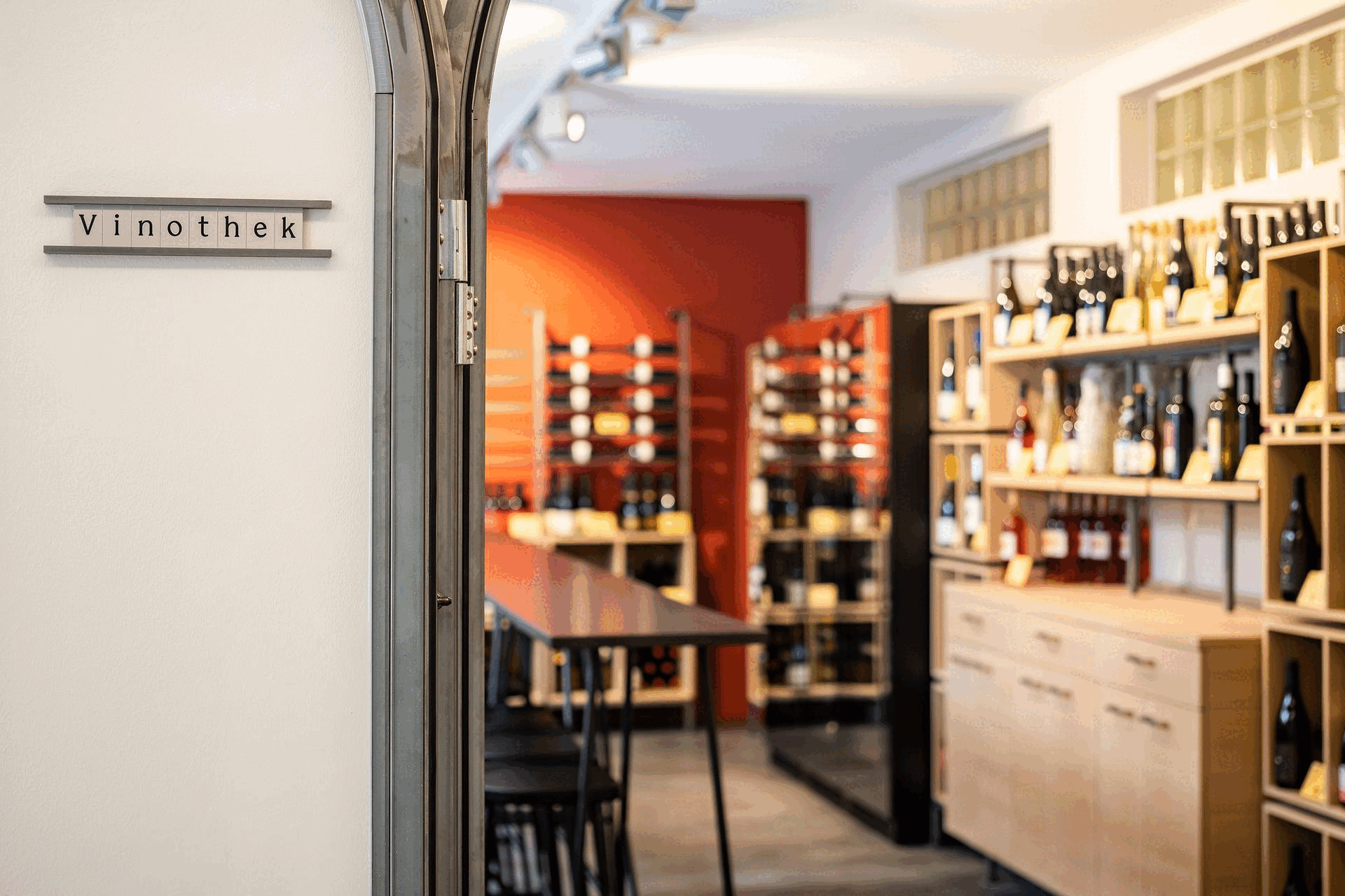
Ground floor: Wine cellar – our walk-in wine list
Ground floor: Wine cellar – our walk-in wine list
The wine cellar is a true paradise for wine lovers. With over 50 selected wines from Switzerland and the Alpine region, it shows that local and Alpine wines have much more to offer than is commonly assumed.
A highlight of the wine list are the indigenous grape varieties – old and rare varieties that have adapted perfectly to the climatic conditions of a region. Here you can learn more about the history behind these wines and feel the passion of the winemakers. The wine list is constantly being revised and increasingly includes organically produced wines and wines from so-called fungus-resistant varieties.
The wine cellar is designed so that you can choose the wines yourself: rows of shelves invite you to browse, and each wine is briefly described. Every month, a wine is selected as the special of the month, which goes particularly well with the seasonal dishes.
Leave the wine cellar and walk past the reception towards the wooden door. Enter the restaurant through the glass door on the right.

Our restaurant
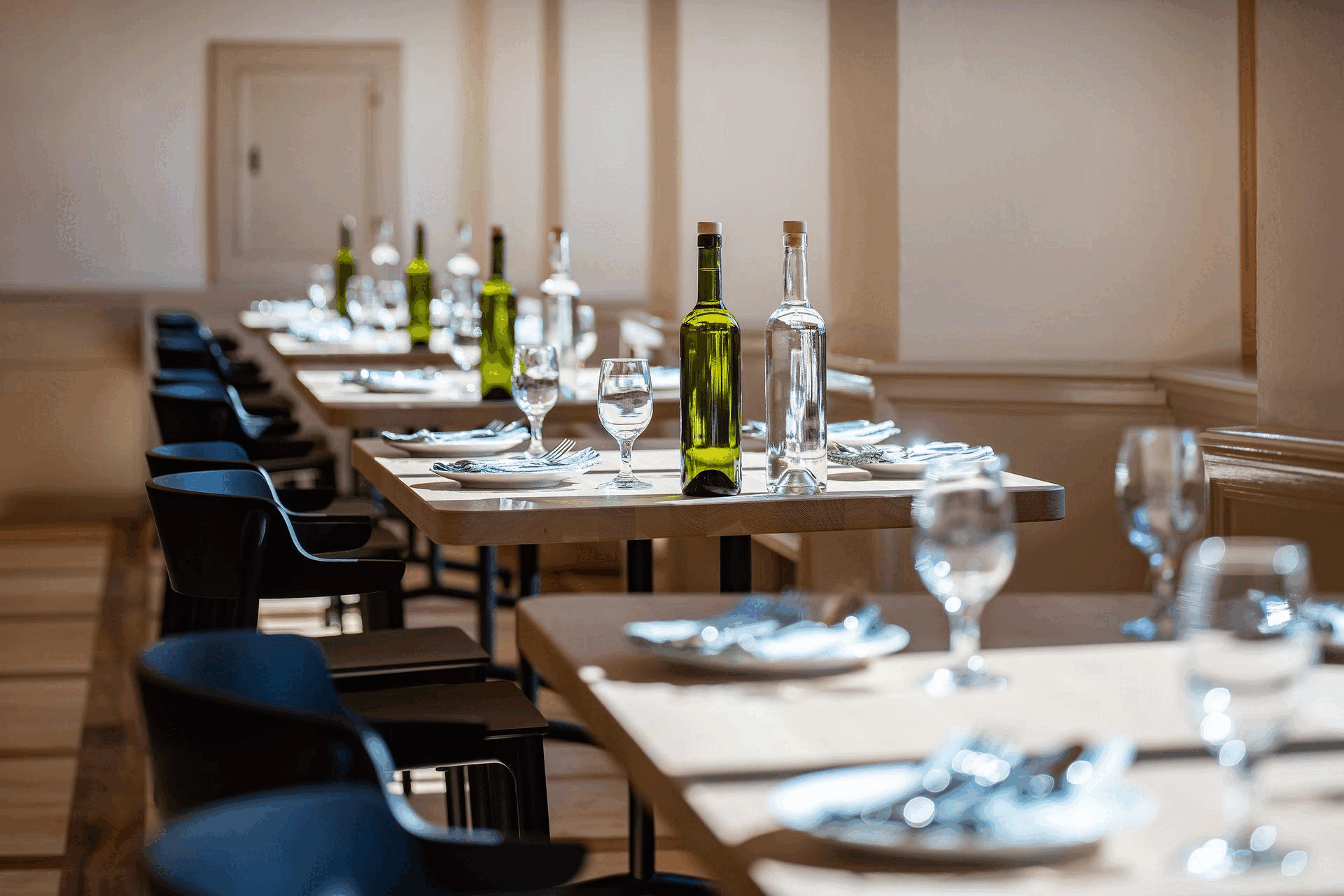
Our restaurant
Our restaurant
Our restaurant is located in the former refectory, the dining hall of the Capuchin monks. The simple yet inviting atmosphere of the room has been preserved, and the cuisine continues the tradition of sharing and enjoyment. For our host Peter Durrer and head chef David Zurfluh, regional authenticity is paramount. They work primarily with authentic and unadulterated regional products from Central Switzerland, preferably organic, supplemented with products from the culinary Alpine region.
Our kitchen team is inspired every day by the seasonal and regionally available ingredients: it is not the menu that determines what we buy, but what is available that determines what we serve. Vegetables from nearby farms, meat from small local butchers and herbs from our own garden find their way into the kitchen. Products such as bread and syrup are made here on site, and surplus produce from the garden or from our producers is preserved in summer so that our guests can enjoy a varied selection even in the winter months. Specialities such as our Alpsbrinz cheese and traditional wild herb dishes reflect the diversity and heritage of the Alps. You won’t find olive oil or lemons in our recipes; we simply replace them with regional products. Food is only imported in exceptional cases, e.g. for coffee or chocolate.
However, this is not an end in itself – on the contrary, we are convinced that this local cuisine is in no way inferior to any other cuisine in the world in terms of taste. But see for yourself and try our surprise tavolata, which best reflects our philosophy on the plate. By the way, did you know that the Tavolata approach also helps to prevent food waste?
Leave the restaurant through the front door and go up the stairs opposite to the first floor. Turn right into the corridor and enter the library on the right. Then walk around the floor with a view of the inner courtyards.

First floor: Rooms, architectural development and sustainability
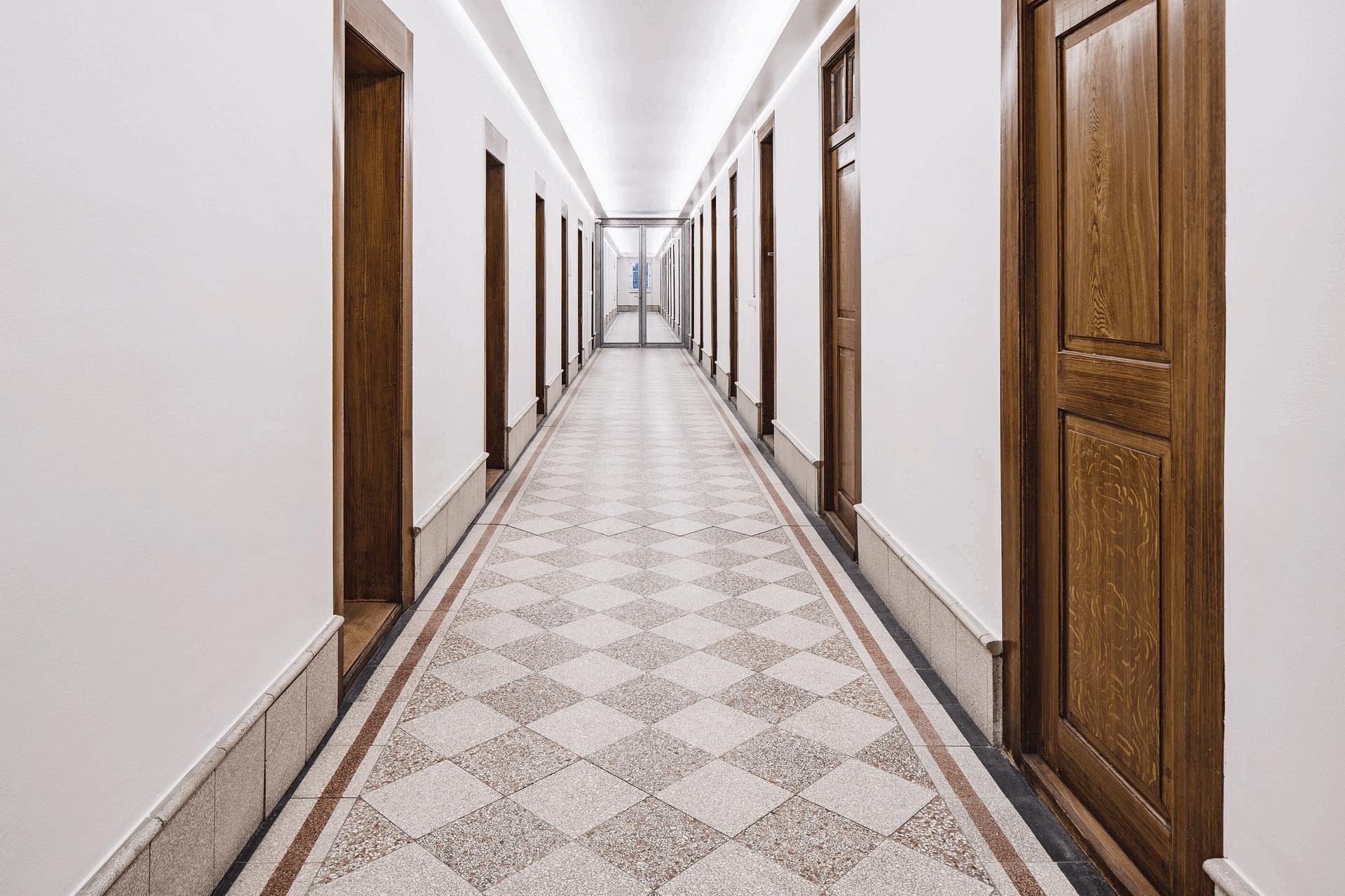
First floor: Rooms, architectural development and sustainability
First floor: Rooms, architectural development and sustainability
The first floor of the monastery shows how skilfully the past and the present have been woven together here. These rooms were once the cells of the Capuchin monks – places of silence and study. Today, they house modern hotel rooms, seminar and conference rooms that have been adapted to the needs of a new era. The hotel rooms are named after old apple varieties, while the seminar rooms are named after well-known Alpine valleys.
The reading room offers a small but fine collection of books and documentation on the culinary heritage of the Alps. It is a place of inspiration and invites our guests to browse. The room also serves as a lounge for guests who wish to retreat for a while.
The monastery was renovated with great respect for the historic building fabric. For example, old masonry was deliberately left intact so that new electricity and water pipes could be installed. These are now visible along the walls and ceilings and contribute to the style of the building.
At the same time, sustainable concepts have been integrated, such as the use of renewable energies and natural materials. This approach reflects the philosophy of the Culinarium Alpinum: preserving the old, integrating the new and always acting sustainably. For example, soap bars are displayed in the corridor on the first floor. The soap bars are waste products from soap production and thus contribute to the sustainable use of our resources. Each guest can take a bar of soap of their choice to their room.
Return to the staircase to go to the second floor. Leave the staircase on the second floor. Turn right twice and go to the end of the corridor and, if free, enter the Klostersaal through the staircase.

Second floor: Monastery hall and garden room
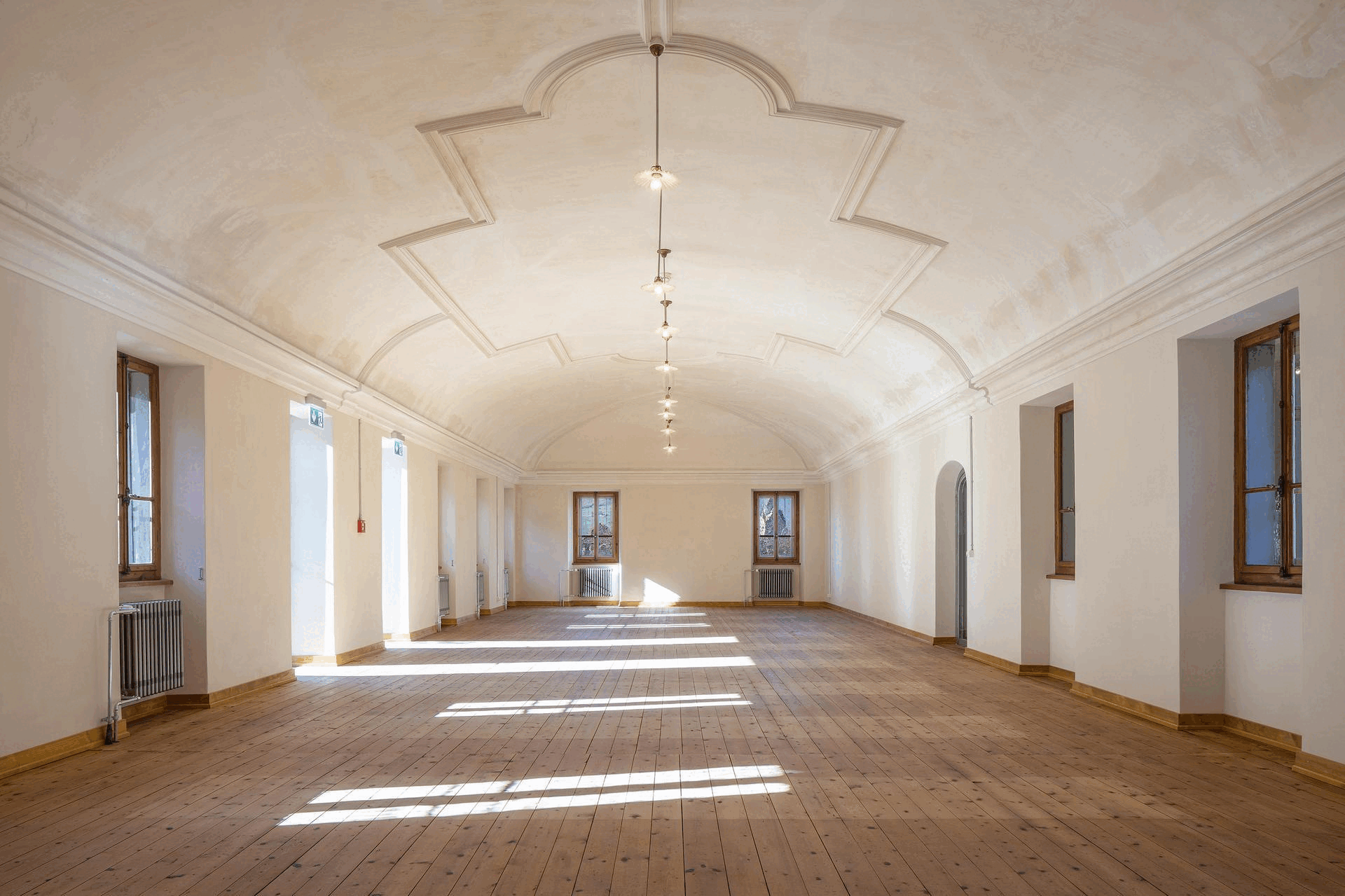
Second floor: Monastery hall and garden room
Second floor: Monastery hall and garden room
Some of the monastery’s most beautiful rooms are located on the second floor.
In the front courtyard facing the village, it is easy to see that the monastery was originally a single-storey building and was then extended by a second floor to its current height. On the north-east wall of the courtyard, there are traces of the original building, on which the masonry of the second floor was built. The windows are also constructed differently in detail. During the same extension phase, the monastery was also extended in length, which is why there are two separate courtyards. Over time, the monastery doubled in length and height, quadrupling in size and accommodating up to 80 people in its heyday.
The monastery hall, with its spacious floor plan, is now a popular venue for conferences, concerts and weddings. Its simple design still recalls its original use as a Capuchin library. The colour differences in the floor are still visible, indicating where the bookshelves once stood.
The adjoining garden room offers a breathtaking view of the edible landscape. With its peaceful atmosphere, it is ideal for wedding receptions, seminar breaks or simply as a place to retreat to during a hectic day.
A separate media guide tour called NaTour is available for the edible landscape, which is particularly worthwhile in the summer months and in dry weather. You can start this tour directly after completing this tour.
Return to the central staircase, walk down three floors to the basement and turn left into the corridor. On your right, you will first find the storeroom and then the Alp Sbrinz cellar. Complete the ‘KulTour’ tour in the monastery shop and stock up on delicacies from the Alpine region.

Basement: Storage cellar, Alp Sbrinz cellar and monastery shop
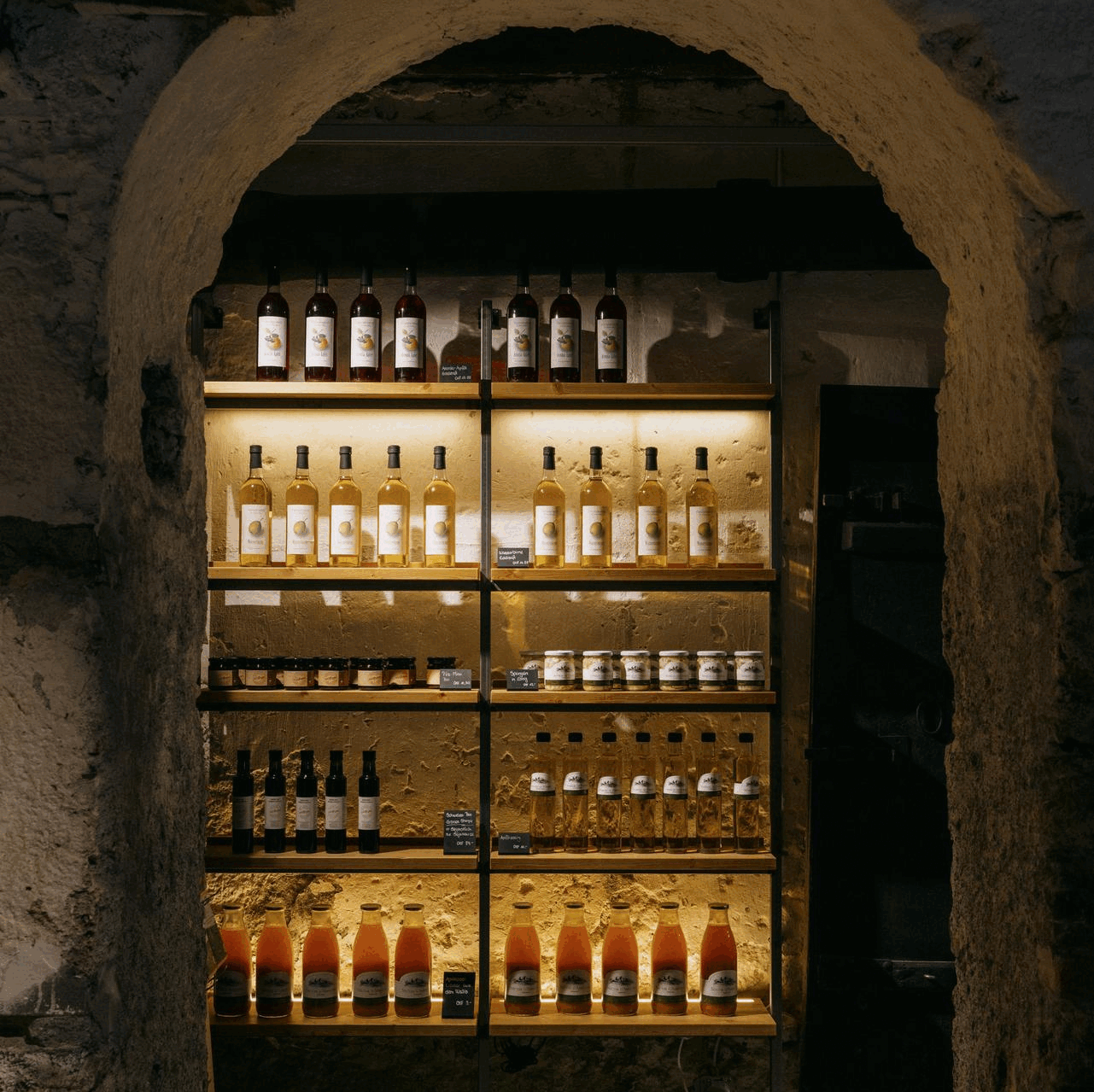
Basement: Storage cellar, Alp Sbrinz cellar and monastery shop
Basement: Storage cellar, Alp Sbrinz cellar and monastery shop
The historic cellar awaits you in the basement. The Capuchin monks used this cellar to store the provisions they received from the villagers and surrounding area as a mendicant order. Today, a new form of storage is practised here: jams, syrups and pickled delicacies from our kitchen are stored here under optimal conditions so that the restaurant can continue to serve regional cuisine even in the winter months.
A special area of the cellar is dedicated to Alpsbrinz. This traditional hard cheese is considered the precursor to Parmesan and has been produced in the region for centuries. Alpsbrinz matures for years to develop its characteristic flavour – nutty, spicy and with a firm consistency. Would you like to take a piece home with you?
The monastery shop next door is more than just a retail outlet – it is a tribute to regional producers and their products. From handmade jams and herbal salts to plant seeds and spirits, every product tells a story. Some of these delicacies are made right here in the monastery, but most come from small farms and manufacturers in the region, who also supply us with products for the kitchen. Most products are also available in our online shop.
The shop is open around the clock, so you can take a piece of Alpine cuisine home with you and spread the values of regionality and sustainability. The book on the ‘Culinary Heritage of the Alps’ is also available here.
Thank you for joining us on this tour. We hope we have given you an insight into our house and our philosophy and inspired you to enjoy Alpine cuisine. The MediaGuide tour ‘NaTour’ in the Edible Landscape starts right outside the door.
See you next time!

